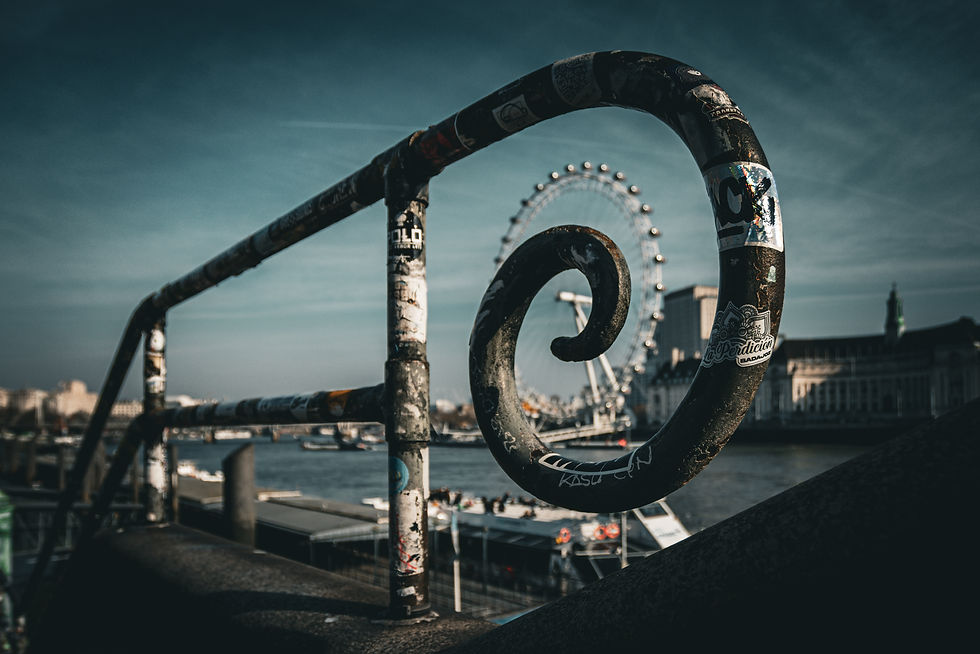Street Photography - Finding a Unique Perspective
- Phil Hargreaves

- Sep 8
- 4 min read
When you’re exploring a city—whether it’s one you’ve lived in for years or a place you’re just passing through—it’s easy to fall into the same set of images and stories everyone else shares: the postcard landmarks, the guidebook highlights, the “must-sees.” Finding a unique perspective means breaking away from well-worn angles and noticing the quieter, often-overlooked details.
I've taken many pictures across London, and I'm going to share a few that stand out to me the most throughout this post. I'm only scratching the surface, but I hope they give you some great locations for you to explore with your camera on your own!

Cities are alive with stories, but when you scroll through endless feeds of urban photography, the images can often blur together: the same landmarks, the same angles, the same predictable snapshots. So how do you find a perspective that feels truly your own? Street photography, at its best, is about slowing down, paying attention, and discovering the overlooked details that make a city unique.
1. Change Your Angle
One of the simplest yet most effective ways to find originality is to shift your viewpoint. Drop low to the ground and use puddles or polished pavements for reflections. Tilt your lens upward to emphasise geometry and scale. Experiment with framing—capture a cathedral dome through the lines of scaffolding, or watch a landmark reflected in a shop window. These small adjustments transform the familiar into something new.

2. Look for Contrasts
Cities thrive on contrast. Photograph the tension between historic stone and sleek glass, or between someone standing still while the world rushes around them. Light and shadow can create striking juxtapositions, too, especially in narrow alleyways where the sun slices through. Contrasts don’t just add visual drama—they tell the deeper story of how a city constantly reshapes itself.

3. Notice the Overlooked
Street photography shines in the details. Look past the grand landmarks and notice hands gripping railings, faded typography on shop signs, or the rhythm of laundry fluttering in backstreets. These are the textures that often escape notice, yet they carry the heartbeat of a city more than any postcard view ever could.

4. Embrace Timing
Timing is everything. The “blue hour” just before sunrise or after sunset lends a cinematic softness, while early mornings offer rare moments of solitude. Rush hour, by contrast, gives you an electric charge of energy and movement. Train your eye to anticipate the rhythm of the street—when someone steps into a shaft of light, when a bus window aligns perfectly with a face inside.


5. Tell Small Stories
Street photography isn’t about documenting places—it’s about revealing relationships. Instead of photographing a landmark on its own, focus on how people interact with it: a tourist leaning for the perfect selfie, an office worker hurrying past without looking up, a child gazing in awe. Each frame becomes a vignette of human life woven into the city’s fabric.
The archways at the Apple Store in Covent Garden carry a quiet kind of grandeur. Once framing a 19th-century market hall, they now hold space for a modern hub of technology. Brick, stone, and curve meet glass and light—history bending to innovation.

What makes these arches compelling is not just their elegance, but their endurance. They’ve watched centuries of footsteps, from traders and market-goers to today’s city wanderers. Passing beneath them, you feel both the weight of the past and the pulse of the present, all woven into the same rhythm of London life.
Lastly, another of my favourite shots in London is The Ship & Shovell.

Tucked away behind Charing Cross station, The Ship & Shovell is one of London’s quirkiest pubs—not just for its name, but for its split personality. It’s the only pub in London (and one of the only ones in the world) that exists in two halves on either side of a narrow alley, joined by a small underground cellar. Step inside one half, then cross the passage to continue your pint in the other.
The pub’s unusual layout is matched by its atmosphere: warm, traditional interiors with deep wood, brass fixtures, and the kind of cosiness that feels unchanged by time. While the West End outside pulses with theatres, traffic, and tourists, The Ship & Shovell offers a tucked-away corner where London slows down.
What makes it so compelling isn’t just the novelty of drinking in two places at once—it’s how this little pocket of eccentricity reflects the city itself: layered, unexpected, and always ready to surprise you if you wander just a street or two off the main road.
---
Ultimately, finding a unique perspective is less about discovering something no one else has ever noticed and more about paying close enough attention that you see it your way.



Comments